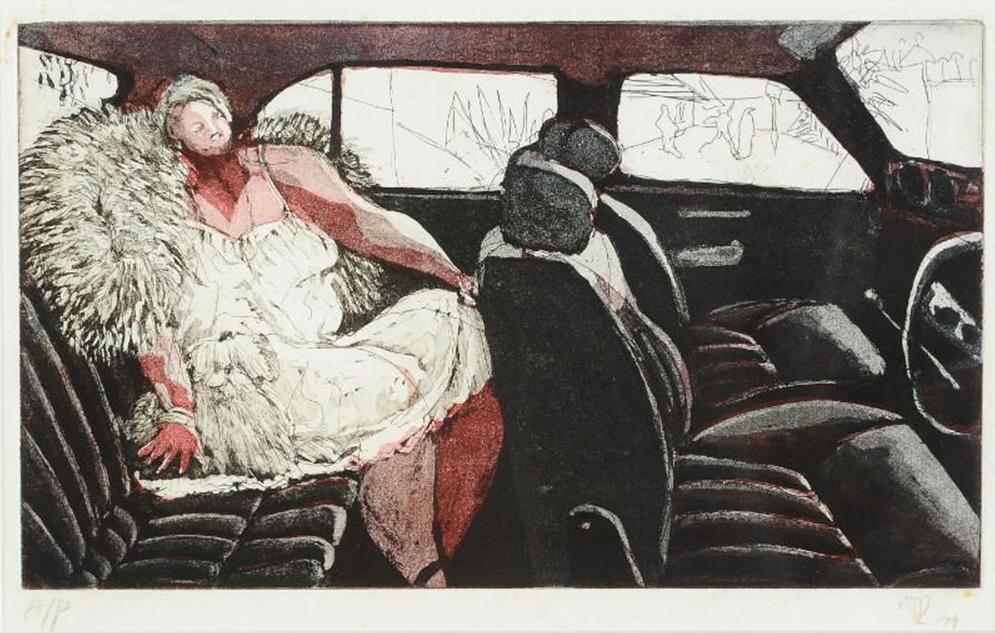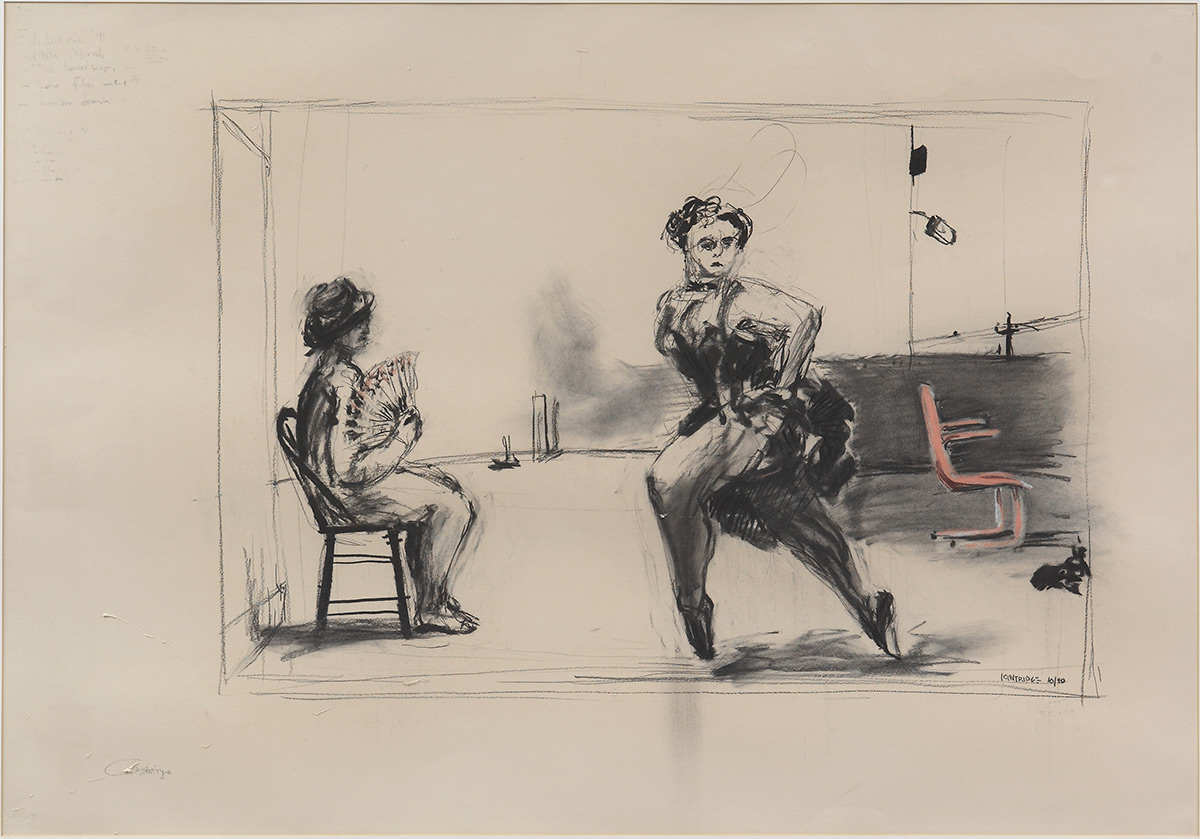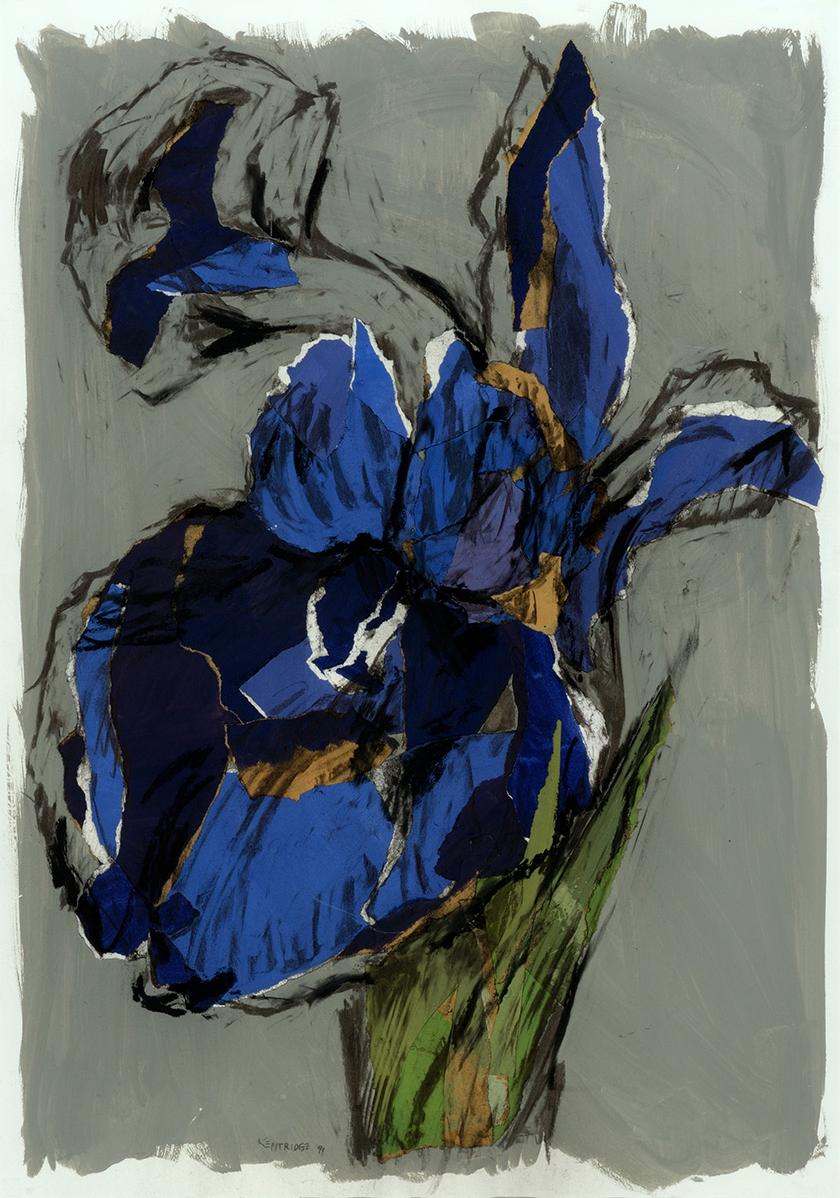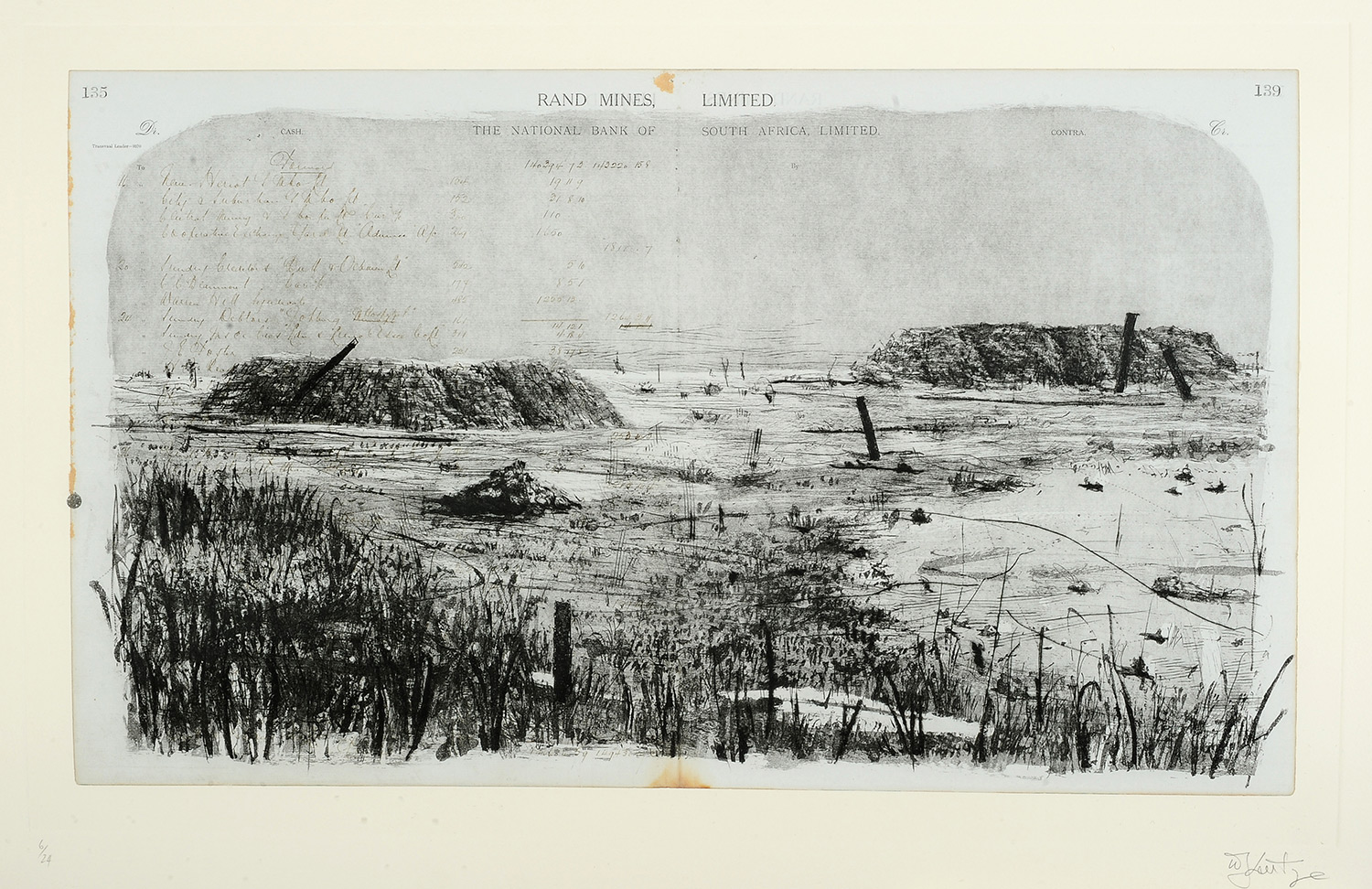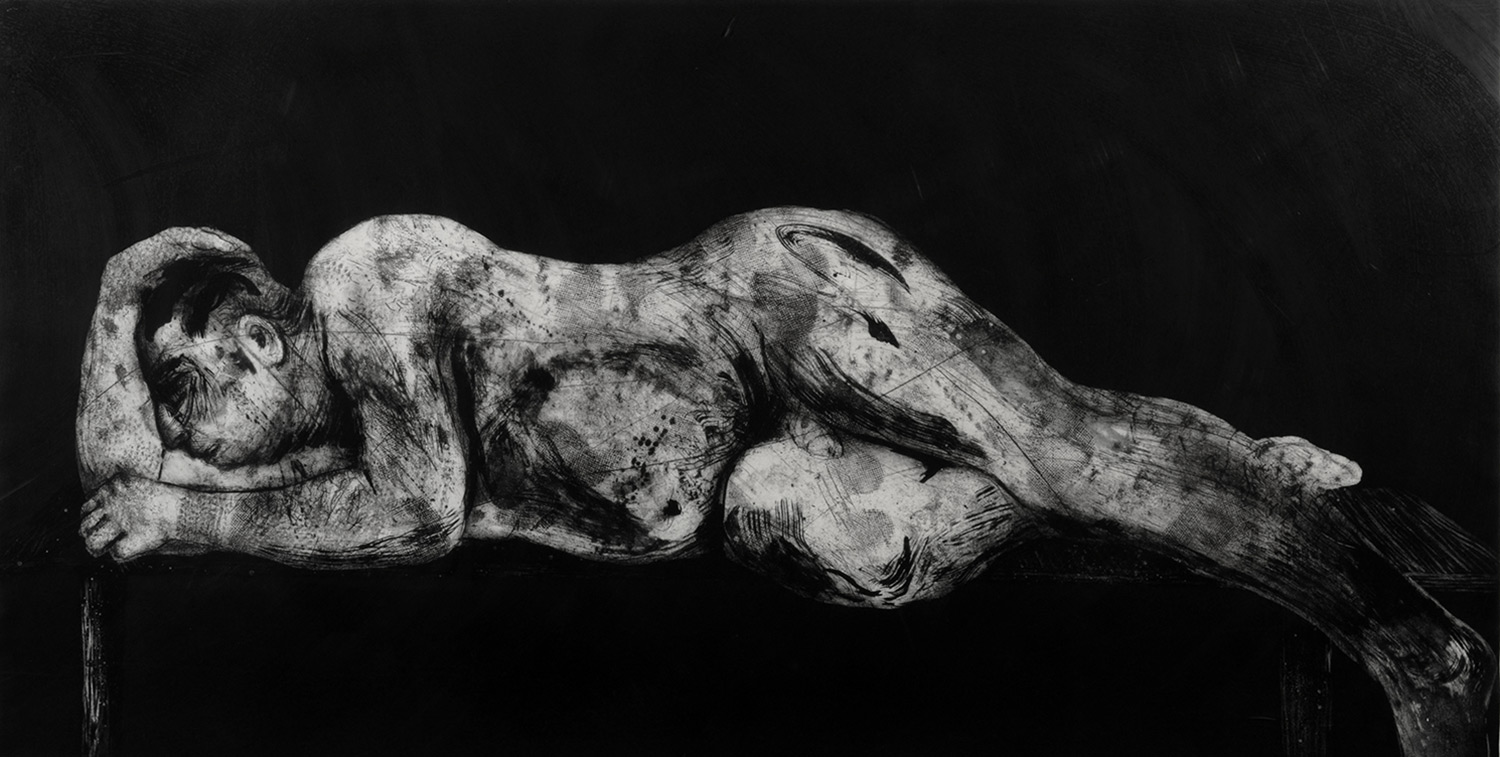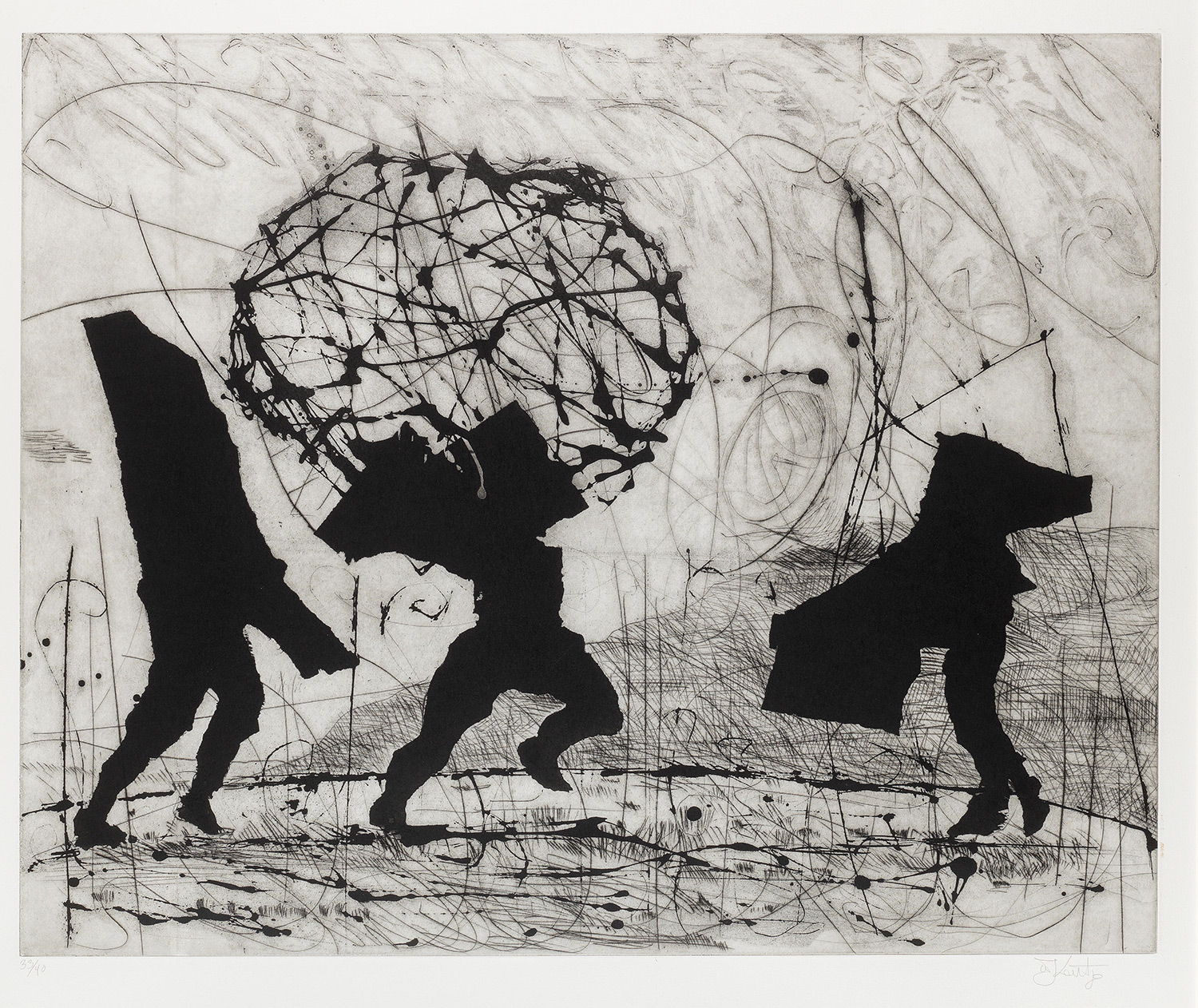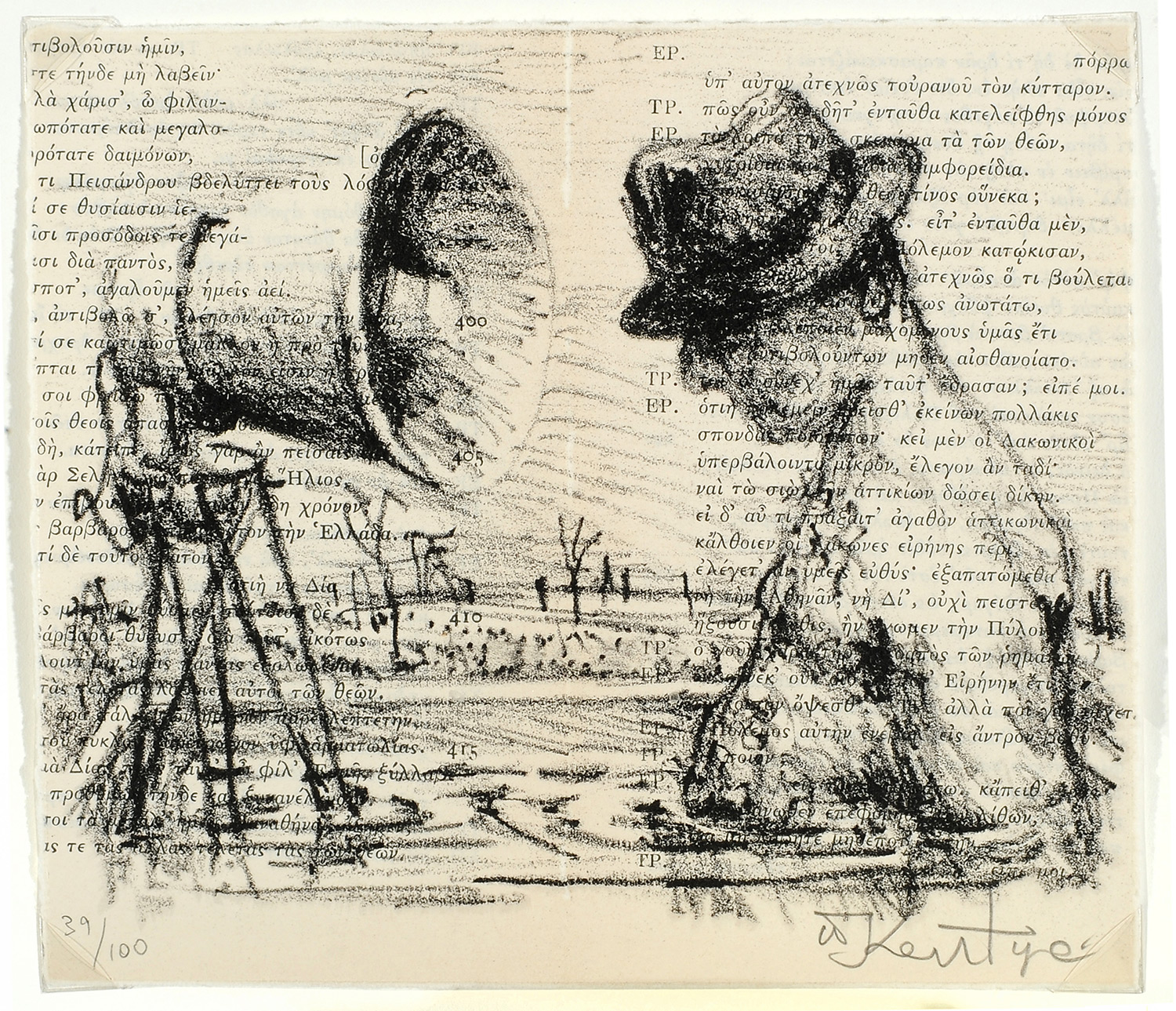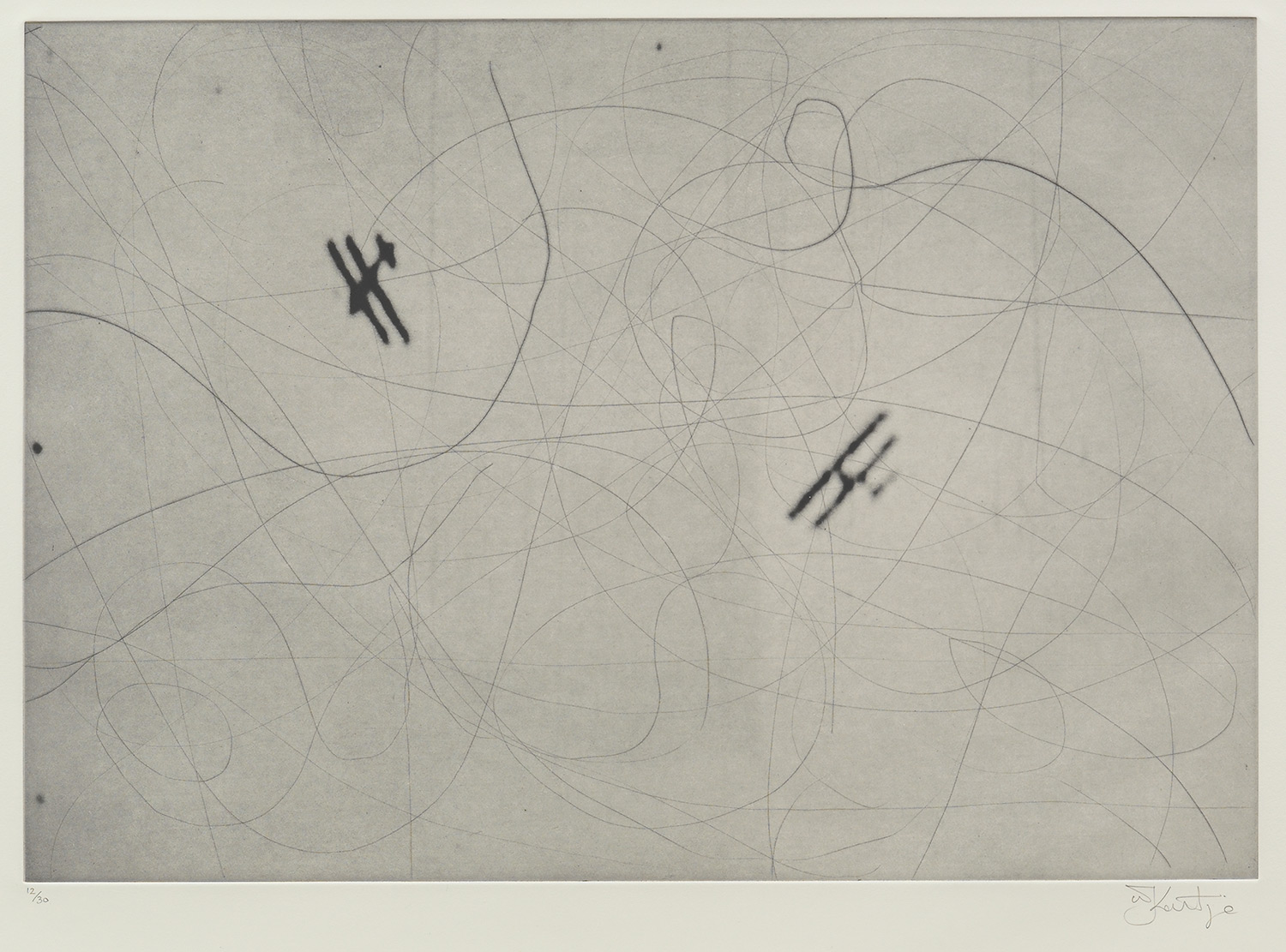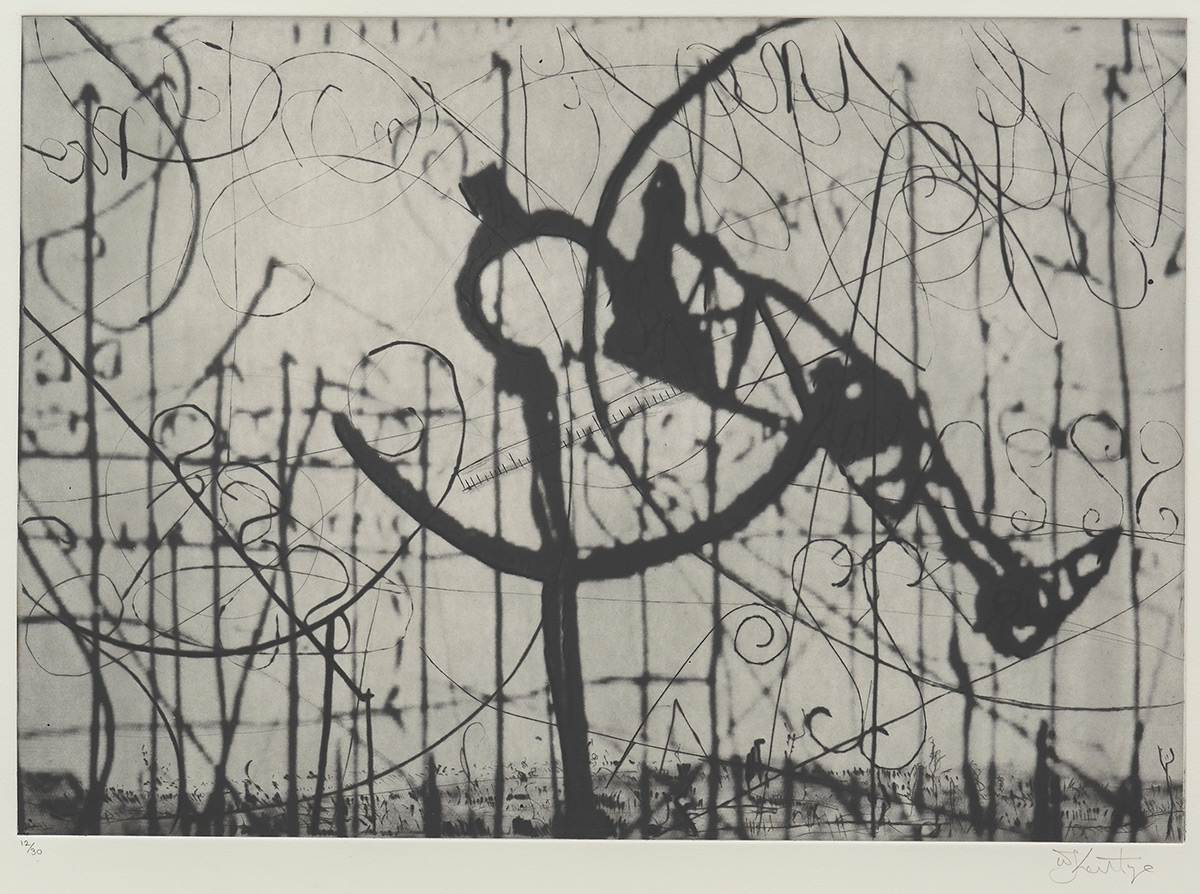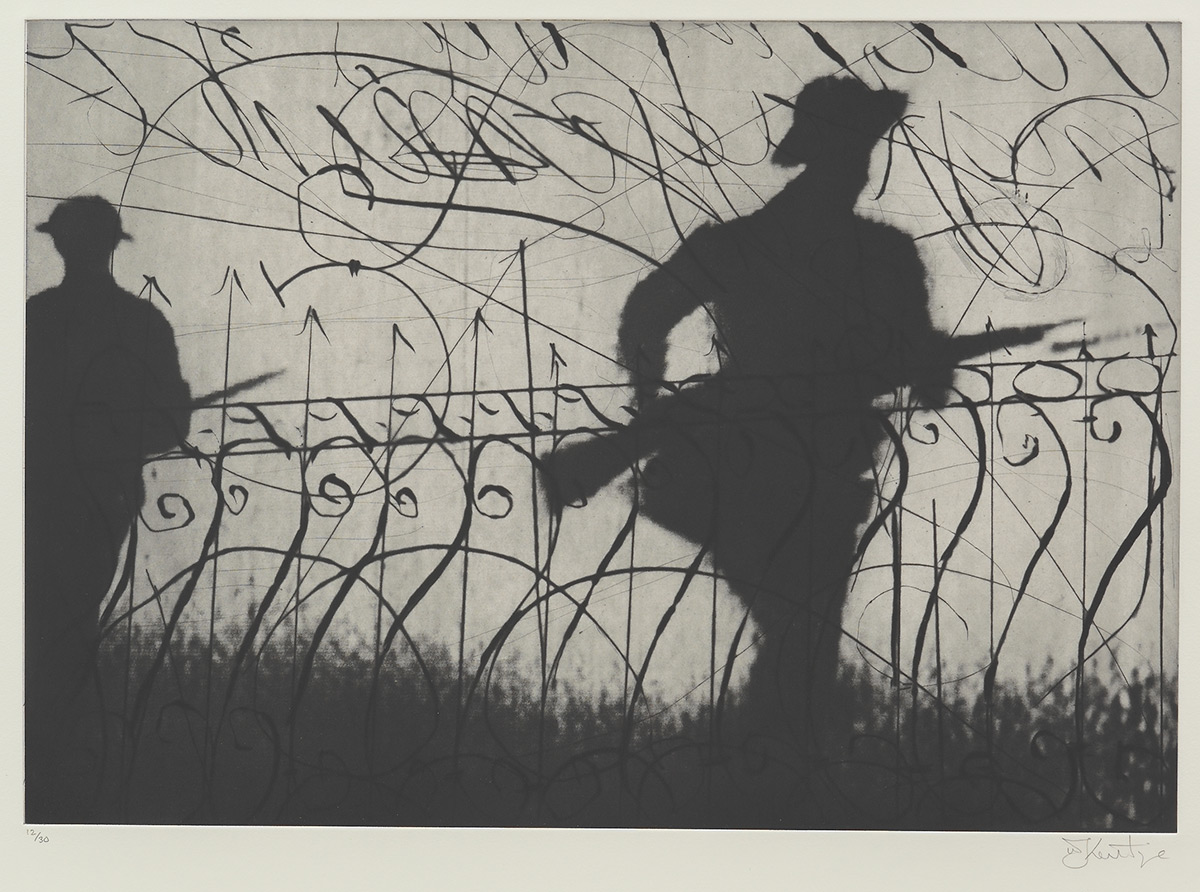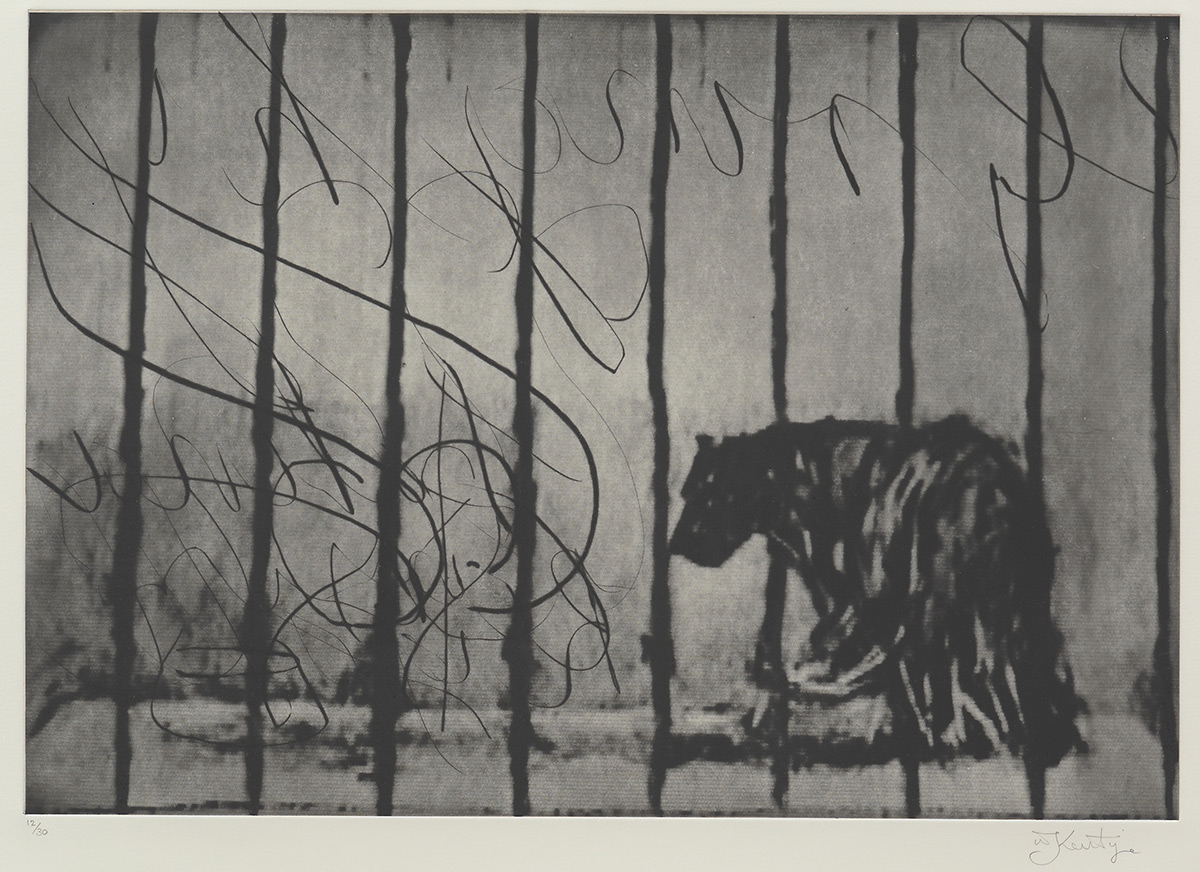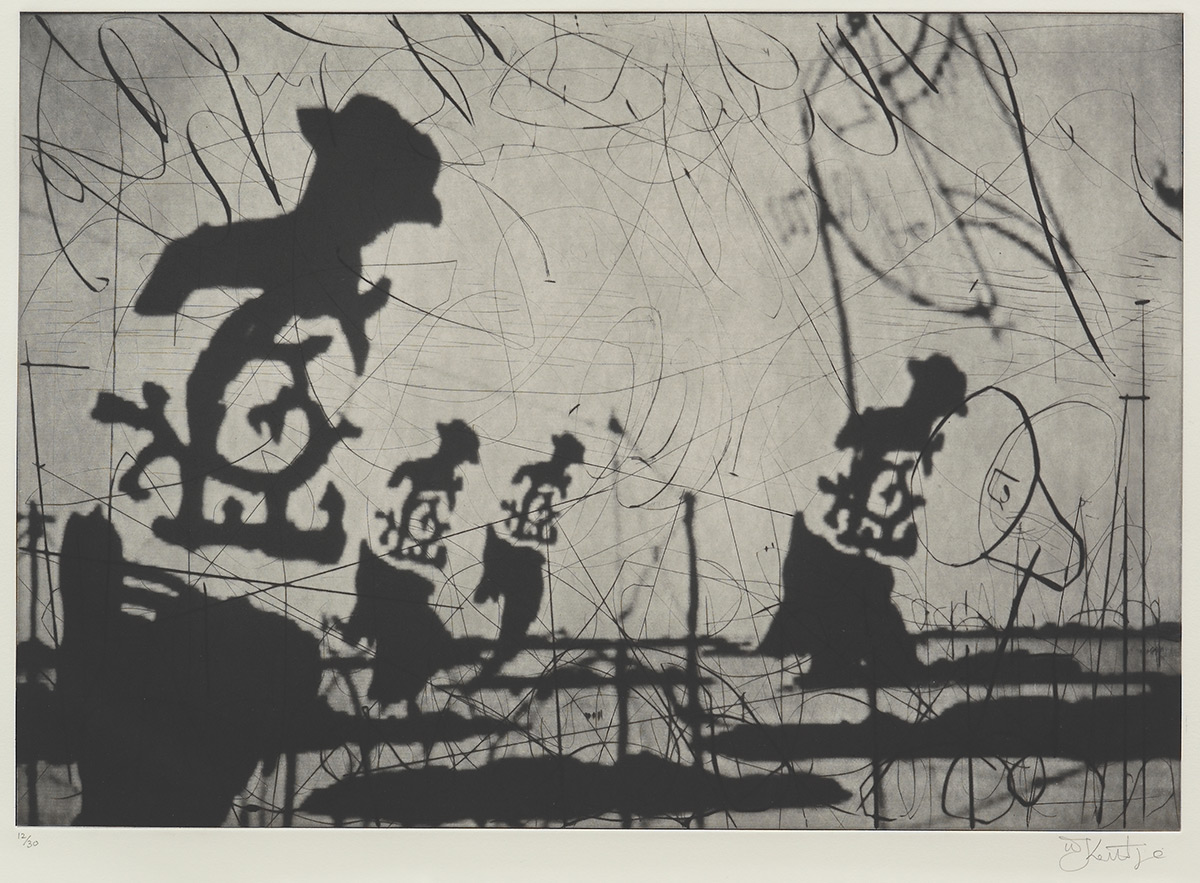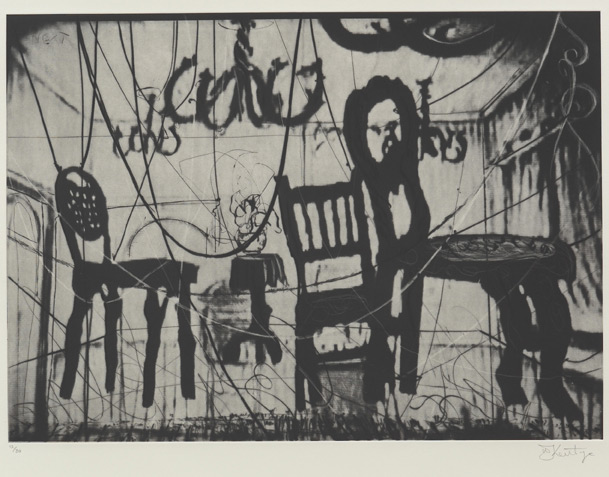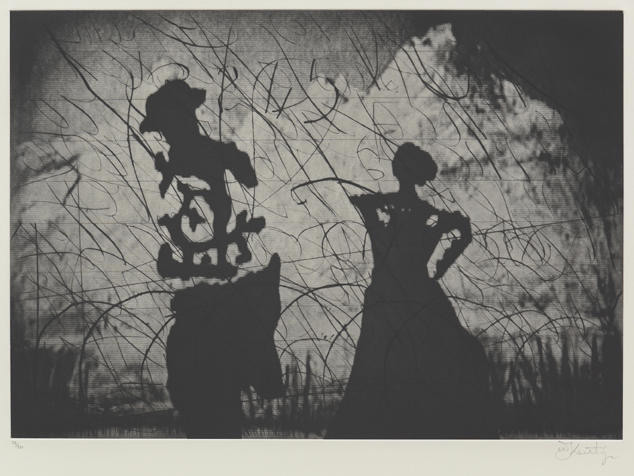William KENTRIDGE (b. 1955)
Car Interior
1979
etching
artist proof
13 x 24 cm
As a student at the University of Witwatersrand in the 1970s, Kentridge focused on politics and African Studies, but then went on to embrace theatre and art, finding them better suited to grappling with the social tension and plight he was experiencing in the world around him. He began to act, write and design sets for the racially integrated Junction Avenue Theatre Company and introduced fine art into his repertoire in 1976–78 while studying at the Johannesburg Art Foundation, where he started making prints and drawings. In 1978, he started to experiment with film and had his first solo show at the Market Gallery in…. Continue Reading
Dancer With Seated Woman
1990
pastel and conté crayon on paper
68.5 x 98.5 cm
Despite his ongoing exploration of other media, the foundation of Kentridge’s art has always been drawing and printmaking. He began acting, writing, and designing sets for the theatre in the 1970s, and his art has always exuded theatricality – both in form and content. Theatricality lies at the heart of all his work, as does a deep sense of physicality – both of which are strongly evident in this pastel and conté crayon drawing of a voluptuous dancer practising her arabesques as a naked figure in a hat looks on fanning him/herself. The relationship between the two figures is oblique and mysterious. The seated figure looks askance, while the dancer seems preoccupied with the fullness of her own presence and movement. Are they fellow performers rehearsing a scene? Could they be lovers?… Continue Reading
Iris
1991
mixed media on paper
97 x 68 cm
When asked whether his work has been critiqued abroad as a contemporary metaphor for South Africa, Kentridge once responded: ‘Yes… maybe a bit too much sometimes. You draw an iris and it’s seen as a metaphor for the end of apartheid. Sometimes an iris is an iris.’ Here is that iris. In this vital still life Kentridge draws on the rich blues and purples of Van Gogh’s iris paintings, introducing in a rare symphony of colour and luscious vibrancy into his largely monochromatic oeuvre.
SOURCES:
http://www.onepeople.com/archive/html/kentrintv.html
https://www.bonhams.com/auctions/21321/lot/206/
Mbinda Cemetery (for Faustus in Africa)
1994
screen print
edition 18/55
64 x 75 cm
This screen print or ‘drawing for projection’ was made by Kentridge as part of Faustus in Africa (1995), a multimedia theatre production featuring puppetry, live acting and animation that he directed in collaboration with Basil Jones and Adrian Kohler’s Handspring Puppet Company (with additional text by Lesego Rampolokeng) and in association with The Market Theatre, Art Bureau (Munich), Kunstfest (Weimar), the Standard Bank National Arts Festival, The Foundation for the Creative Arts and Mannie Manim Productions.
Like Woyzeck on the Highveld (1992) and Ubu and the Truth Commission (1997), Faustus in Africa reconsidered a canonical European literary text from an African perspective. Faust trades his soul for a colonist’s open ticket… Continue Reading
Rand Mines Ledger
1999
etching
edition 6/24
37 x 62 cm
Kentridge has written extensively on concepts of landscape and memory, making the connection between the exploitation of the land and of South Africa’s people under apartheid. He has commented on the long tradition of the South African landscape in paintings – in particular the celebratory landscapes of Jan Volschenk (1853 – 1936), and JH Pierneef (1886 – 1957) – referring to their versions of the South African landscape as ‘documents of disremembering’. He has also noted how the landscape of Auschwitz bears little to no trace of the World War II carnage.
On the contrary, Kentridge’s landscapes deliberately lay bare… Continue Reading
Sleeper – Black
1997
etching
artist proof
96 x 189 cm
Sleeper – Black (1997) is one of the etchings produced as part of the film project Ubu Tells the Truth (1997), which was originally created to form part of the multimedia theatre work, Ubu and the Truth Commission (1997), in which Kentridge collaborated with the Handspring Puppet Company… Continue Reading
Three Shadow Figures
2003
sugar lift and dry point etching
edition 13/40
76 x 90.5 cm
This etching draws on Kentridge’s sustained experiments in shadow theatre – for years he has deployed shadow figures or dark silhouettes ripped from construction paper and collaged against the patterns of 19th-century atlas maps.
These ‘shadow figure’ works culminated in his video installation, Shadow Procession, which depicts a haunting procession of black puppet-like figures made from cardboard cutouts. The figures, hunched and crippled, move from left to right across the screen, hauling their belongings – donkeys, carts, chairs, sacks, even whole towns on their backs – as if in an exodus. Humans, animals and the indeterminate figures in between carry their burdens, sacks, bundles and houses. Some lead others by the hand, some carry gallows and bodies. Some drag entire neighbourhoods on their backs
Influenced by the brutality of apartheid, Shadow Procession… Continue Reading
Untitled (from Stereoscope)
1997
lithograph
edition 39/100
12 x 13.5 cm
This lithograph was made along with the animated film Stereoscope, the eighth in Kentridge’s decade-long series featuring Soho Eckstein, the archetypal white Johannesburg businessman of the post-apartheid era and an alter ego of the artist. The role of drawings in Kentridge’s oeuvre has developed over time. Initially created in service to his films, they gradually took on a more independent life, and in 1992, the artist began showing them separately.
Here, Eckstein is depicted submerged in a pool/bath/reservoir of water, absorbing the sounds emitting from an outsize bullhorn or loud hailer that has been rigged up in the middle of the veld. There is no escape from the assault of the news or propaganda it seems. Eckstein has to cope with the horrifying past of his country, Kentridge has written, and find a line ‘between choosing a more solitary life or being promiscuously social’. But even when Eckstein attempts to relax or retreat into the private realm from the relentlessness public life of the… Continue Reading
Zeno Writing I
2002
photogravure with dry point and engraving (suite of seven photogravures)
edition 12/30
50 x 65 cm
This print was created in conjunction with the film, Zeno Writing, which was made in relation to Confessions of Zeno, a theatrical multimedia performance produced for Documenta 11. Confessions of Zeno was a collaboration with The Handspring Puppet Company, Kevin Volans, The Duke Quartet and Dawid Minnaar.
‘The film piece is based on Italo Svevo’s 1923 novel of the same name, Zeno is a prisoner of his own intelligence, who psychoanalyses himself in a fictive dialogue with his analyst, fretting in a stream-of-consciousness narrative about the constant need to take a stance in the politically troubled society that exists after World War I. ‘By resituating Zeno’s Trieste in the suburbs of 1980s Johannesburg, Kentridge explores, once again, the intricacies of growing up… Continue Reading
Zeno Writing II
2002
photogravure with dry point and engraving (suite of seven photogravures)
edition 12/30
50 x 65 cm
This print was created in conjunction with the film, Zeno Writing, which was made in relation to Confessions of Zeno, a theatrical multimedia performance produced for Documenta 11. For further information about this body of work, see text accompanying Zeno Writing I, above.
Zeno Writing III
2002
photogravure with dry point and engraving (suite of seven photogravures)
edition 12/30
50 x 65 cm
This print was created in conjunction with the film, Zeno Writing, which was made in relation to Confessions of Zeno, a theatrical multimedia performance produced for Documenta 11. For further information about this body of work, see text accompanying Zeno Writing I, above.
Zeno Writing IV
2002
photogravure with dry point and engraving (suite of seven photogravures)
edition 12/30
50 x 65 cm
This print was created in conjunction with the film, Zeno Writing, which was made in relation to Confessions of Zeno, a theatrical multimedia performance produced for Documenta 11. For further information about this body of work, see text accompanying Zeno Writing I, above.
Zeno Writing V
2002
photogravure with dry point and engraving (suite of seven photogravures)
edition 12/30
50 x 65 cm
This print was created in conjunction with the film, Zeno Writing, which was made in relation to Confessions of Zeno, a theatrical multimedia performance produced for Documenta 11. For further information about this body of work, see text accompanying Zeno Writing I, above.
Zeno Writing VI
2002
photogravure with dry point and engraving (suite of seven photogravures)
edition 12/30
50 x 65 cm
This print was created in conjunction with the film, Zeno Writing, which was made in relation to Confessions of Zeno, a theatrical multimedia performance produced for Documenta 11. For further information about this body of work, see text accompanying Zeno Writing I, above.
Zeno Writing VII
2002
photogravure with dry point and engraving (suite of seven photogravures)
edition 12/30
50 x 65 cm
This print was created in conjunction with the film, Zeno Writing, which was made in relation to Confessions of Zeno, a theatrical multimedia performance produced for Documenta 11. For further information about this body of work, see text accompanying Zeno Writing I, above.
BIOGRAPHY
William Kentridge is a world-renowned South African artist, filmmaker and theatre director. He was born in Johannesburg. Descendants of Jewish refugees from the purges and pogroms of Russia and Europe, his parents Sydney Kentridge and Felicia Geffen were both lawyers renowned for their defence of victims of apartheid.
Kentridge studied Politics and African Studies at the University of the Witwatersrand before pursuing Fine Arts at the Johannesburg Art Foundation. He trained in theatre at the L’École Internationale de Théâtre Jacques Lecoq in Paris, which influenced his multidisciplinary approach.
His method combines drawing, writing, film, performance, music, theatre, and collaborative practices to create works of art that are grounded in politics, science, literature and history. His unique technique involves creating hand-drawn animations by repeatedly altering a charcoal drawing and photographing each stage, allowing the images to evolve through erasure and transformation. This method highlights the traces of change, reflecting themes of memory and time. His palimpsest-like drawings are later displayed along with the films as finished pieces of art.
His work delves into the socio-political landscape of Johannesburg during and after apartheid, addressing themes like colonialism, identity and social inequality. His later work has expanded to global themes of displacement and human rights, always maintaining a focus on ambiguity and complexity.
Kentridge’s work has been seen in major museums and galleries around the world since the 1990s, including the Museum of Modern Art in New York, the Albertina Museum in Vienna, Musée du Louvre in Paris, Whitechapel Gallery in London, Louisiana Museum in Copenhagen, the Reina Sofia museum in Madrid, the Kunstmuseum in Basel, Zeitz MOCAA and the Norval Foundation in Cape Town and the Royal Academy of Arts in London. He has participated a number of times in Documenta in Kassel (2012, 2002, 1997) and the Venice Biennale (2015, 2013, 2005, 1999 and 1993).
Opera productions include Mozart’s The Magic Flute, Shostakovich’s The Nose, and Alban Berg’s operas Lulu and Wozzeck, and have been seen at opera houses including the Metropolitan Opera in New York, La Scala in Milan, English National Opera in London, Opera de Lyon, Amsterdam opera, the Sydney Opera House and the Salzburg Festival.
Kentridge’s theatrical productions, performed in theatres and at festivals across the globe include Refuse the Hour, Winterreise, Paper Music, The Head & the Load, Ursonate, Sibyl and The Great Yes, The Great No and, in collaboration with the Handspring Puppet Company, Ubu & the Truth Commission, Faustus in Africa!, Il Ritorno d’Ulisse and Woyzeck on the Highveld.
In 2016, Kentridge founded the Centre for Less Good Idea in Johannesburg: a space for responsive thinking and making through experimental, collaborative and cross-disciplinary arts practices. The centre hosts an ongoing programme of workshops, public performances, and mentorship activities.
Kentridge is the recipient of honorary doctorates from several universities including Yale, London University and Columbia University. In 2010, he received the Kyoto Prize. In 2012, he was awarded the Commandeur dans l’ordre des Arts et des Lettres in France and he presented the Charles Eliot Norton Lectures at Harvard University. In 2015, he was appointed an Honorary Academician of the Royal Academy in London. In 2017, he received the Princesa de Asturias Award for the arts, and, in 2018, the Antonio Feltrinelli International Prize. In 2019, he received the Praemium Imperiale award in painting in Tokyo. In 2021, he was made a Foreign Associate Member to the French Académie des Beaux Arts, Paris. In 2022, he was presented the Honour of the Order of the Star of Italy and in 2023 he received the Olivier Award for Outstanding Achievement in Opera for Sibyl in London.
His work can be found in the collections of Art Gallery of Western Australia (Perth), Art Institute of Chicago, Carnegie Museum of Art (New York), San Diego Museum of Art, Fondation Cartier (Paris), Zetiz MoCAA (Cape Town), Norval Foundation (Cape Town), LACMA (Los Angeles), Haus der Kunst (Munich), Sharjah Art Foundation, Mudam (Luxembourg), Musée d’Art Contemporain de Montreal, MoMA (New York), SF MoMA (San Francisco), Castello di Rivoli (Turin), Moderna Museet, Stockholm, MoCA (Los Angeles), Stedelijk Museum (Amsterdam), National Gallery of Victoria (Melbourne), Johannesburg Art Gallery, MAXXI (Rome), Louisiana Museum (Humlebaek,Denmark), National Gallery of Canada (Ottawa), National Museum of Modern Art (Kyoto), Israel Museum (Jerusalem), Inhotim Museum (Brumadinho, Brazil), Broad Art Foundation, Los Angeles, Centre Pompidou (Paris), Fondation Louis Vuitton (Paris), National Gallery of Australia (Canberra), Tate Modern (London), Sifang Art Museum (Nanjing), Kunsthalle Mannheim, Vehbi Koç Foundation (Istanbul), Luma Foundation (Arles), Museum of Fine Arts (Budapest), Fundació Sorigué (Lleida, Spain), Guggenheim (Abu Dhabi), Kunsthalle Praha (Prague) and Amorepacific Museum of Art (Seoul); as well as private collections worldwide.


